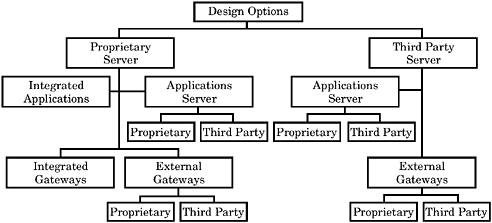It is apparent that client/server IP-PBX designs differ across models. There are even major design differences within one supplier’s product family. For example, the Cisco Systems 7750 ICS all-in-one design is radically different from the supplier’s larger MCS 7825/7835 multiple server cluster design; Siemens offers client/server models based on a closed, embedded Windows NT server or a customer-provided server option. Client/server IP-PBX designs may be far simpler than traditional circuit switched PBXs and converged IP-PBX platforms, but there is a sufficient number of design variables to create major differences between system models.
Figure 1 shows how three layers (call telephony server, gateways, and applications) of a client/server IP-PBX can be designed and integrated into the system architecture. The choices available to a designer include a proprietary or a nonproprietary call telephony server, integrated or external advanced applications support, integrated or external gateways. Gateways and application servers may be a mix of proprietary or third-party solutions. Designers may select proprietary components for quality control and development of feature/function options capabilities not supported by third-party solutions. Third-party components may reduce system costs and provide customers with more design flexibility in their purchase decisions.
Several IP-PBXs originally designed using third-party call telephony servers were redesigned with customized servers because distributors and customers often failed to use a third-party server with the technical specifications as recommended by the supplier. Several manufacturers that currently offer a proprietary call telephony server model plan to migrate their systems to a less expensive third-party server solution, but not until all the system design bugs and problems are solved after one or two system generations.
If issues related to proprietary or third-party components are not part of the customer-buying equation, there are other important design and performance criteria to be evaluated before a purchase decision is made. System reliability and survivability are as important when evaluating a client/server IP-PBX as they are in a circuit switched PBX design—port capacity, traffic handling, and call processing power. The following is a summary checklist of design performance issues for evaluating a client/server IP-PBX (many unique to an IP telephony communications system):
-
System redundancy—Fully duplicated or shared back-up components for call processing, memory, and power functions
-
System port capacity—Stations (IP, non-IP) and trunk interfaces (analog, T1/E1, IP)
-
System traffic handling capacity—Distribution of gateway channels and conference circuits
-
System call processing—BHCC
-
Supported call control protocols and interfaces—H.323, SIP, MGCP, SGCP, MEGACO, etc.
-
Voice codec support—G.711, G.723.1, G.729(A,B), GSM, etc.
-
QoS support—DiffServ, 802.1p/Q, COS, TOS, IP precedence, RSVP, dynamic jitter buffer, packet loss replacement
-
Standard messaging system interfaces—AMIS-A, VPIM, LDAP, IMAP
The first client/server IP-PBX systems were shipped less than 5 years ago, and in that time the design and performance capabilities have changed significantly. It will take several more years until the product design stabilizes, and its reliability is comparable to current circuit switched PBXs, which have been shipping for more than 25 years. Although a new generation of data communications systems seems to appear every year or two, new voice communications system platforms take many years to evolve.


No comments:
Post a Comment